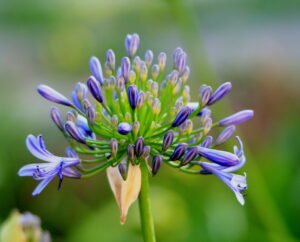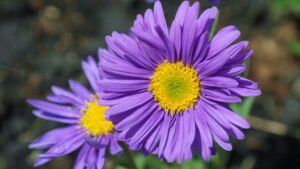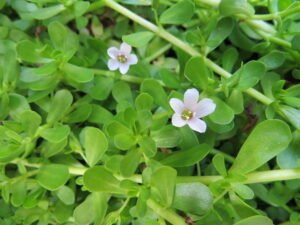How To Grow And Care For Rose of Sharon

Rose of Sharon Flower
When it comes to gardening, there are few plants that can match the beauty and elegance of the Rose of Sharon. This flowering shrub, also known as Hibiscus syriacus, is native to Asia and is a member of the mallow family. It is known for its large, showy flowers that come in a variety of colors, including white, pink, purple, and blue. The Rose of Sharon is a popular choice among gardeners because of its ability to thrive in a wide range of conditions. This article explains in detail how to grow and care for Rose of Sharon.

One of the standout features of the Rose of Sharon is its long blooming season, which typically lasts from summer to fall. This extended period of blossoming ensures that your garden remains vibrant and colorful for a significant portion of the year. The flowers attract bees, butterflies, and hummingbirds, making it a favorite among nature enthusiasts.
How To Care For Rose of Sharon
Right Location
Before you start growing your Rose of Sharon plant, it’s important to choose the right location for it. This plant thrives in full sun, so make sure to select a spot in your garden that receives at least 6-8 hours of direct sunlight each day. Additionally, the Rose of Sharon plant prefers well-draining soil, so ensure that the soil in your chosen location is loose and fertile.
When considering the location for your Rose of Sharon plant, it’s also important to take into account its mature size. These plants can reach heights of up to 10 feet and have a spread of 6-8 feet, so make sure to choose a spot that allows for adequate growth and expansion. Avoid planting it too close to other plants or structures, as it may overshadow or crowd them.
Additionally, take into account the local weather and climate. While the Rose of Sharon plant is known for its hardiness and ability to tolerate a wide range of climates, it still thrives best in areas with moderate temperatures and consistent rainfall. If you live in an area with extreme heat or cold, you may need to provide additional protection or choose a more suitable plant for your garden.
In addition to sunlight, soil, and climate, it’s also important to consider the aesthetic aspect of the location. The Rose of Sharon plant is known for its beautiful, showy flowers that bloom in a variety of colors, including white, pink, purple, and red. Choose a location that allows the plant to be a focal point in your garden or complements the overall design and color scheme.
Lastly, consider the accessibility of the chosen location. Make sure it’s easily accessible for regular maintenance tasks such as watering, pruning, and fertilizing. Having the plant in a convenient spot will make it easier for you to care for and enjoy its beauty throughout the growing season.
Watering
Watering Methods
There are several methods you can use to water your Rose of Sharon plant effectively:
- Soaker Hose: A soaker hose is a great option for watering your Rose of Sharon. It allows water to slowly seep into the soil, ensuring that it reaches the roots without wasting water through evaporation.
- Drip Irrigation: Another efficient method is drip irrigation. This system delivers water directly to the base of the plant, minimizing water loss and ensuring that the roots receive a consistent supply of moisture.
- Hand Watering: If you prefer a more hands-on approach, you can use a watering can or hose with a gentle spray nozzle to water your Rose of Sharon. Make sure to water at the base of the plant, avoiding wetting the foliage to prevent diseases.
Monitoring Soil Moisture
It’s important to monitor the moisture level of the soil to ensure you’re providing the right amount of water for your Rose of Sharon. Here are a few tips:
- Place your finger up to the second knuckle in the ground. If the soil feels dry at that depth, it’s time to water.
- Use a moisture meter to get an accurate reading of the soil moisture level. These tools are easy to use and can help you determine when it’s time to water.
- Observe the plant for signs of water stress, such as wilting leaves or drooping branches. These are indications that the plant needs water.
Watering in Different Seasons
The watering needs of your Rose of Sharon can vary depending on the season:
- Spring: During the spring months, when the plant is actively growing, it may require more frequent watering to support new growth.
- Summer: In the hot summer months, it’s crucial to water your Rose of Sharon deeply and regularly to prevent dehydration and stress.
- Fall: As the temperatures cool down in the fall, you can gradually reduce the frequency of watering. However, make sure the plant receives enough moisture to prepare for winter.
- Winter: In winter, the Rose of Sharon goes dormant, and its watering needs decrease significantly. Use water sparingly—only if the soil gets too dry.
By following these watering tips and monitoring the moisture levels of your Rose of Sharon plant, you can ensure its health and promote beautiful blooms throughout the growing season.
Fertilizing
When it comes to growing a healthy and vibrant Rose of Sharon, fertilizing is an essential step that should not be overlooked. Fertilizing provides the necessary nutrients for the plant to thrive, ensuring it produces an abundance of beautiful flowers.
When selecting a fertilizer for your Rose of Sharon, it’s important to choose one that is specifically formulated for flowering plants. Look for a fertilizer with a balanced ratio of nitrogen, phosphorus, and potassium, such as a 10-10-10 or 20-20-20 blend. These nutrients are crucial for promoting healthy growth and blooming.
The best time to fertilize your Rose of Sharon is in early spring, just as new growth begins to emerge. This will give the plant a boost of nutrients to support its growth throughout the season. You can also fertilize again in mid-summer to encourage continued blooming.
When applying fertilizer to your Rose of Sharon, it’s important to follow the instructions on the packaging. Typically, you’ll want to sprinkle the granules evenly around the base of the plant, being careful not to get any on the leaves. To ensure that the nutrients reach the soil, give the plant lots of water after applying the fertilizer.
Mulching
After watering, apply a layer of mulch around the base of the Rose of Sharon plant. Mulch aids in controlling soil temperature, weed suppression, and moisture conservation. Use organic mulch such as wood chips or straw, and spread it about 2-3 inches thick.
The mulch should be spread in a circle around the plant, starting about 2 inches away from the stem and extending out to the drip line. Avoid piling the mulch directly against the stem, as this can cause rot and other diseases.
Staking (if necessary)
If your Rose of Sharon plant is tall or has weak stems, it may benefit from staking. This is especially important if you live in an area with strong winds or if the plant is located in an open area. Use stakes made of bamboo or metal, and secure them to the plant with soft ties or twine.
Make sure the stakes are placed outside the root zone and are driven deep enough into the ground to provide adequate support. Avoid tying the plant too tightly to the stakes, as this can restrict growth and cause damage.
Pruning and Maintenance
Regular pruning and maintenance are essential for keeping your Rose of Sharon plant healthy and looking its best. Here’s what you need to know:
Pruning
Prune your Rose of Sharon plant in late winter or early spring before new growth begins. Eliminate any branches that are overloaded or crossing, as well as any that are dead or damaged. This will encourage healthy development and better air circulation.
When pruning, it’s important to make clean cuts just above a bud or lateral branch. This will encourage new growth in the desired direction and prevent the plant from becoming too dense. Additionally, removing any suckers or water sprouts that may emerge from the base of the plant will help maintain its shape and prevent it from becoming unruly.
Deadheading
Deadheading, or removing spent flowers, can help prolong the blooming period of your Rose of Sharon plant. Simply snip off the faded flowers with a pair of sharp pruning shears. Be sure to cut just above a set of healthy leaves or buds to encourage new growth.
In addition to promoting continuous blooming, deadheading also prevents the plant from wasting energy on producing seeds. By removing the spent flowers, you redirect the plant’s resources towards developing new buds and maintaining its overall health.
Winter Protection
In colder climates, it’s important to provide winter protection for your Rose of Sharon plant. Apply a layer of mulch around the base of the plant to insulate the roots and protect them from freezing temperatures.
Before applying mulch, make sure to remove any fallen leaves or debris from around the plant. This will help prevent the growth of fungal diseases and pests during the winter months. Additionally, you can wrap the plant with burlap or use a protective cover to shield it from harsh winds and heavy snowfall.
Remember to remove any winter protection in early spring once the threat of frost has passed. This will allow the plant to receive ample sunlight and air circulation, which are crucial for its growth and development.
By following these pruning and maintenance practices, you can ensure that your Rose of Sharon plant remains healthy, vibrant, and a beautiful addition to your garden for years to come.
Dealing with Pests and Diseases
While the Rose of Sharon plant is generally resistant to pests and diseases, it can still be affected by a few common issues. Here are some tips for dealing with them:
Aphids
If you notice aphids on your Rose of Sharon plant, simply spray them off with a strong stream of water or use insecticidal soap to control the infestation. Aphids are tiny insects that damage leaves and stems by feeding on the sap of plants. By removing them physically or using a mild soap solution, you can effectively eliminate their presence and protect your Rose of Sharon from further damage.
Japanese Beetles
Japanese beetles can cause significant damage to the foliage of your Rose of Sharon. These shiny green and copper-colored beetles feed on the leaves, flowers, and buds of the plant, leaving behind skeletonized foliage. To control their population, you can handpick the beetles off the plant and drop them into a bucket of soapy water. Alternatively, you can use a natural insecticide specifically formulated to target Japanese beetles. Applying the insecticide according to the instructions on the product label will help protect your Rose of Sharon from these voracious pests.
Fungal Diseases
Some fungal diseases, such as powdery mildew, can affect the leaves of your Rose of Sharon. Powdery mildew is a common fungal infection characterized by a white, powdery coating on the leaves and stems. To prevent these diseases, it is important to provide adequate spacing between plants to ensure good air circulation. This will help reduce the humidity around the plants, making it less favorable for fungal growth. Additionally, avoid overhead watering as it can create a moist environment that promotes the development of fungal diseases. Instead, water the plants at the base to keep the foliage dry and minimize the risk of fungal infections.
By following these tips and implementing proper pest and disease management practices, you can ensure that your Rose of Sharon remains healthy and vibrant, providing you with beautiful blooms year after year.





